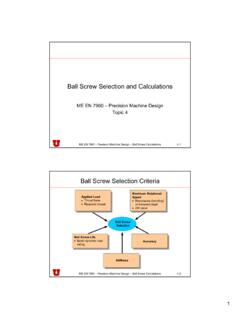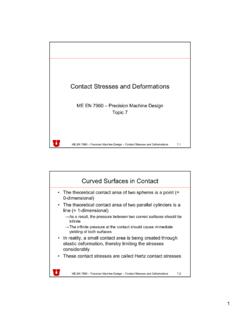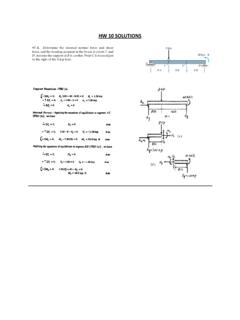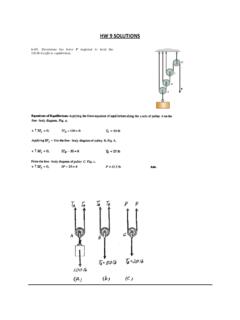Transcription of Introduction to Compressible Flow - University of Utah
1 1 Introduction to Compressible Flow0 DtD The density of a gas changes significantly along a streamlineCompressible FlowDefinition of Compressibility: the fractional change in volume of the fluid element per unit change in pressure ppppvdpp+dpp+dpp+dpp+dvv Compressible Number:2. Compressibility becomes important for High Speed Flows where M > M < Subsonic & incompressible <M < Subsonic & Compressible <M < transonic flow shock waves appear mixed subsonic and sonic flow regime <M < - Supersonic shock waves are present but NO subsonic flow M > Hypersonic Flow, shock waves and other flow changes are very strongsound of speed velocitylocal==cVM2 Compressible Flow3.
2 Significant changes in velocity and pressure result in density variations throughout a flow field4. Large Temperature variations result in density a result we now have two new variables we must solve for:T & We need 2 new will solve: mass, linear momentum, energy and an equation of Effects of Compressibility on Flow1. Choked Flow a flow rate in a duct is limited by the sonic condition 2. Sound Wave/Pressure Waves rise and fall of pressure during the passage of an acoustic/sound wave. The magnitude of the pressure change is very Shock Waves nearly discontinuous property changes in supersonic flow.
3 (Explosions, high speed flight, gun firing, nuclear explosion)4. A pressure ratio of 2:1 will cause sonic flowApplications1. Nozzles and Diffusers and converging diverging nozzles2. Turbines, fans & pumps3. Throttles flow regulators, an obstruction in a duct that controls pressure One Dimensional Isentropic Flow Compressible pipe Control volume approach Steady, One-dimension, Uniform Flow Additional Thermodynamics Concepts are needed Restrict our analysis to ideal gasesThermodynamics Equation of State Ideal Gas LawRTp =Temperature is absolute and the specific volume is (volume per unit mass).
4 1=vK)J/( )J/(kmol8314air of massMolecular Constant Gas Universal = ===muMRRT hermodynamics Internal Energy & Enthalpy Internal Energy individual particle kinetic energy. Summation of molecular vibrational and rotational energy. For an ideal gas Recall from our integral form of the Energy Equation for Enthalpyof an ideal gas:dvvudTTuudTv + =~~~()Tvuu,~~=dTcudv=~()Tuu~~=)(Thh=dTcd hp=pvuh+=~4 Thermodynamics Internal Energy & EnthalpydTcdhp=RdTuddhRTuhpvuh+=+=+=~~~R Tp= dTcudv=~Substituting:constRccRccRdTdTcdT cRdTuddhvpvpvp== +=+=+=~Thermodynamics Internal Energy & EnthalpyDefine the ratio of specific heats:constcckvp= Then,11 = =kRckkRcvpFor Air.
5 Cp= 1004 J/kg-Kk = 2ndLaw of Thermodynamics & Isentropic ProcessesCombining the 1stand 2ndLaws gives us Gibb s EquationrevTQds = We define entropy by: = = =212121pdpRTdTcdsdpdTcTdsdpdhTdspp dTcdhp=pRT= 15 The 2ndLaw of Thermodynamics & Isentropic ProcessesFor an Isentropic process: adiabatic and reversibleWe get the following power law relationship 121212lnlnppRTTcssp = kkkTTpp = = 1211212 Control Volume Analysis of a Finite Strength Pressure Wavec0=VTp TTpp + + + V Moving Wave of Frontal Area AThe Speed of sound (c) is the rate of propagation of a pressure wave of infinitesimalstrength through a still TTpp + + + VcV =Stationary WaveReference frame moving with wave()()()()()()()(A) 021 + = + += += ++ = = cVVccAVccAdAVcdAcdAnVCSrSteady State Continuity Equation(Solve for the induced velocity V).
6 12 Control Volume Analysis of a Finite Strength Pressure WaveSmall Amplitude moderate frequency waves are isentropic and cVTp= TTpp + + + VcV =()()() ()(B) 12 VcpcVccAApppAVVmdAnVVFCSxx = = + = = &rSteady State Momentum Equation:(Find pand c)12 Now combine A & B and solve for the speed of sound:0 oflimit in the 122 = + = + = pcppcconstpk= 6 Control Volume Analysis of a Finite Strength Pressure WaveCalculating the Speed of Sound for an ideal gas:constpk= pkp= kRTpkc== kRTc=Typical Speeds of SoundFluidc (m/s)Gases:H21,294 Air340 Liquids:Water1,490 Ethyl Alcohol1,200 Data From White =vpcckFor Air:K)J/(kg287 =RExample 1: Speed of sound calculationDetermine the speed of sound in Argon (Ar) at 120 oC.
7 MW = 40 kg/kmol:kRTc= =vpcckK)J/( )J/(kmol8314 = ==muMRR()() of a sound sourceand wave propagationV = 0V < cV > c Source moves to the right at a speed VMcV1sin== Zone of silenceV t3 c tV tV tMach cone7 Example 2: a needle nose projectile traveling at a speed of M=3 passes 200m above an observer. Find the projectiles velocity and determine how far beyond the observer the projectile will first be heard200 m M =3xExample 2: a needle nose projectile traveling at a speed of M=3 passes 200m above an observer. Find the projectiles velocity and determine how far beyond the observer the projectile will first be heard()()() = ======= Steady Isentropic Flow Control Volume AnalysisApplications where the assumptions of steady, uniform, isentropic flow are reasonable:1.
8 exhaust gasses passing through the blades of a Diffuser near the front of a jet engine3. Nozzles on a rocket engine4. A broken natural gas line8 Steady Isentropic FlowpTh VdppdTTddhh++++ dVV+dx()()( )()dAdVddVAddAdVAdVdAVdVAdVdAAVVAdAAdVVd VAAVAVdAnVCS +++++++=+++=+ = = 222111 0rSteady State Continuity Equation:12 Steady Isentropic FlowpTh VdppdTTddhh++++ dVV+dx()()( )()dAdVddVAddAdVAdVdAVdVAdVdAAVVAdAAdVVd VAAVAVdAnVCS +++++++=+++=+ = = 222111 0rSteady State Continuity Equation:Only retain 1storder differential terms & divideBy VAVdVdAdA++= 012~ 0~ 0~ 0~ 0 Steady Isentropic FlowpTh VdppdTTddhh++++ dVV+dx()( )()12122122~~2pvupvuzzgVVmWQs+ ++ + = &&&Steady State Energy Equationwith 1 inlet & 1 exit:Neglecting potential energy and recalling: pvuh+=~1221222hhVVmWQs + = &&&()1221222 TTcVVmWQps + = &&&Assuming and ideal gas: 129 Steady Isentropic FlowpTh VdppdTTddhh++++ dVV+dxSteady State Energy Equationwith 1 inlet & 1 exit, neglecting potential energy & assuming Isentropic duct flow:12122222hVhV+=+Assuming and ideal gas.
9 12122222 TcVTcVpp+=+1212221212 RTkkVRTkkV += +12 Stagnation ConditionsAssume the area A2is so big V2 ~ 0,thenohhVh=+=1212212 Stagnation enthalpyTcVTpo+=2212122222 TcVTcVpp+=+Similarly, as we adiabatically bring a fluid parcel to zero velocitythere is a corresponding increase in temperatureInsolatedwallsStagnation TemperatureStagnation Conditions maximum velocityTcVTpo+=22If the temperature, T is taken taken down to absolute zero, then (+) can be solved for the maximum velocity:(+)opTcV2max=No higher velocity is possible unless energy is added to the flow through heat transfer or shaft Conditions Mach number relations12112112222222+ =+ =+=+=MkcVkTTcTVTTTcVTopopoFor Ideal gases:111 = =kkRTTkkRTcppc2c1212+ =MkTToRecall, that the Mach number is defined as:cVM=Stagnation Conditions Isentropic pressure & density relationships11211121121121 + = = + = =kkookkkkooMkTTMkTTpp 1212+ =MkTToCritical Values: conditions when M = 1 +=12*kTTo1*12 +=kkokpp11*12 +=kok 21*12 +=kcco11 Critical Values.
10 Conditions when M = *= += *= += *= += kok For Air k = *= +=kccoIn all isentropic flow, all critical values are Values: conditions when M = 1 Critical Velocity: is the speed of sound c*2121**1212 += +===kkRTkckRTcVoo21*12 +=kccoExample 3: Stagnation ConditionsAir flows adiabatically through a duct. At point 1the velocity is 240 m/s, with T1= 320K and p1= 170kPa. Compute(a) To(b) Po(c) ro(d) M(e) Vmax(f) V*12 Steady Isentropic Duct FlowpTh VdppdTTddhh++++ dVV+dxRecall, for Steady isentropic flow Continuity:VdVdAdA++= 0 For Compressible , isentropic flow the momentum equationis:VdVdpdVdp+=+= 202 Bernoulli s Equation!






